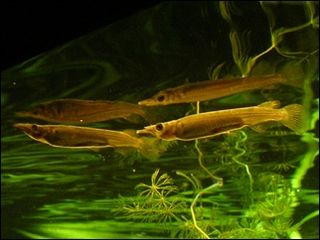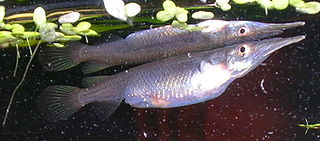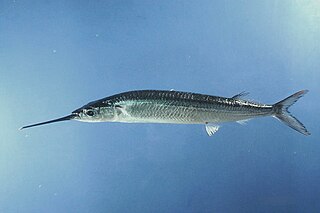Hemiramphidae is a family of fishes that are commonly called halfbeaks, spipe fish or spipefish. They are a geographically widespread and numerically abundant family of epipelagic fish inhabiting warm waters around the world. The halfbeaks are named for their distinctive jaws, in which the lower jaws are significantly longer than the upper jaws. The similar viviparous halfbeaks have often been included in this family.

The wrestling halfbeak also known as Malayan halfbeak is a species of viviparous halfbeak native to the fresh and brackish waters of rivers and coastal regions in South-East Asia, in Singapore, Thailand, Indonesia, Thailand, Malaysia, Borneo and Sumatra. It is a small, slender, livebearing fish, with the elongated lower jaw characteristic of its family. The colour of this species varies, depending on where the specimen is found. It is the type species of the genus Dermogenys.
The ballyhoo halfbeak, ballyhoo, balahu, redtailed balao or yellowtail ballyhoo is a baitfish of the halfbeak family (Hemiramphidae). It is similar to the Balao halfbeak in most features. Some are used for trolling by saltwater anglers. Some have caused ciguatera poisoning in humans.

The emerald shiner is one of hundreds of small, silvery, slender fish species known as shiners. The identifying characteristic of the emerald shiner is the silvery emerald color on its sides. It can grow to 3.5 inches in length and is found across North America from Canada to the Gulf of Mexico, commonly in large, deep lakes and rivers, though sometimes in smaller bodies of water as well. It feeds on small organisms such as zooplankton and insects, congregating in large groups near the surface of the water. It is a quite common fish and is often used as a bait fish.
Nomorhamphus megarrhamphus is a species of viviparous halfbeak, a freshwater fish endemic to Lake Towuti in Sulawesi, Indonesia.
Nomorhamphus weberi is a species of viviparous halfbeak endemic to Lake Matano in Sulawesi, Indonesia. This species can reach a length of 7.5 centimetres (3.0 in) SL. The specific name honours the Dutch ichthyologist Max Carl Wilhelm Weber (1852-1937).
The Poso halfbeak is a species of viviparous halfbeak endemic to Lake Poso and its tributaries in Sulawesi, Indonesia.
Tondanichthys kottelati is a species of viviparous halfbeak endemic to Indonesia, where it is only known from Lake Tondano near Mount Tondano in the far north of the island of Sulawesi. It grows to a length of 6.4 centimetres (2.5 in) SL. Despite being a member of the viviparous halfbeak family, this species is believed to be oviparous. This species was described in 1995 by Bruce Baden Collette and its species name honours the Swiss ichthyologist Maurice Kottelat.

The Balao halfbeak, occasionally called the Balao for short, is an ocean-going species of fish in the family Hemiramphidae. It was first described by the French naturalist Charles Alexandre Lesueur in 1821. They are used as cut bait and for trolling purposes by saltwater sportsmen.

Hyporhamphus is a genus of halfbeaks. The species in this genus are distributed throughout the warmer seas of the world, most species being Indo-Pacific and there are some freshwater species.
Rhynchorhamphus georgii or long-billed halfbeak is a halfbeak of the family Hemiramphidae of the order Beloniformes.

The American halfbeak, also known as Meek's halfbeak, is a halfbeak from the family Hemiramphidae.
The Congaturi halfbeak, also known as the Valenciennes halfbeak, is a potamodromous species of fish in the family Hemiramphidae. It is a valued commercial fish in tropical countries both dried salted and fresh forms.

Zenarchopteridae, the viviparous halfbeaks, is a family in the order Beloniformes. The Zenarchopteridae exhibit strong sexual dimorphism, practicing internal fertilisation, and in some cases ovoviviparous or viviparous. The members in the family are mainly found in fresh and brackish water of tropical Asia and New Guinea, but the genus Zenarchopterus also includes marine species from the Indo-Pacific. Several, such as the wrestling halfbeak, have become commonly traded aquarium fish.
The feathered river garfish, also known as the estuarine halfbeak, spoon-fin garfish, spoon-fin river garfish and viviparous half beak, is a species of marine, freshwater, brackish and reef-associated oceanodromous viviparous halfbeak found in Indo-Pacific regional countries, such as Kenya, Mozambique, Seychelles, Madagascar, New Guinea, Solomon Islands, Australia, New Caledonia, Fiji, Sri Lanka, India, Vanuatu, Malaysia, Thailand, Singapore and Samoa.

Nomorhamphus ebrardtii is a species of viviparous halfbeak, a ray-finned fish in the family Zenarchopteridae, endemic to brackish and freshwater locations in Sulawesi and the neighbouring island of Kabaena in Indonesia. This species can reach a length of 9 cm (3.5 in) SL.
The Longfin halfbeak is an ocean-going species of fish in the family Hemiramphidae native to the eastern Pacific Ocean.

Hyporhamphus unifasciatus, the common halfbeak or the Atlantic silverstripe halfbeak, is a bony fish in the family Hemiramphidae. It is found in the subtropical western Atlantic Ocean and the Gulf of Mexico. It is a common fish and not used for food to any great extent, and the International Union for Conservation of Nature has listed its conservation status as being of "least concern".
Oxyporhamphus similis, the false halfbeak, is a species of halfbeak from the family Hemiramphidae which is found in the warmer waters of the Atlantic. In the eastern Atlantic its distribution extends from Cape Verde to Angola while in the western Atlantic it occurs from New York State south through the Caribbean and Gulf of Mexico to Recife in Brazil. This species was described by the Danish ichthyologist Anton Frederik Bruun in 1935,
Dermogenys brachynotopterus, the Gangetic halfbeak, is a species of viviparous halfbeak.







